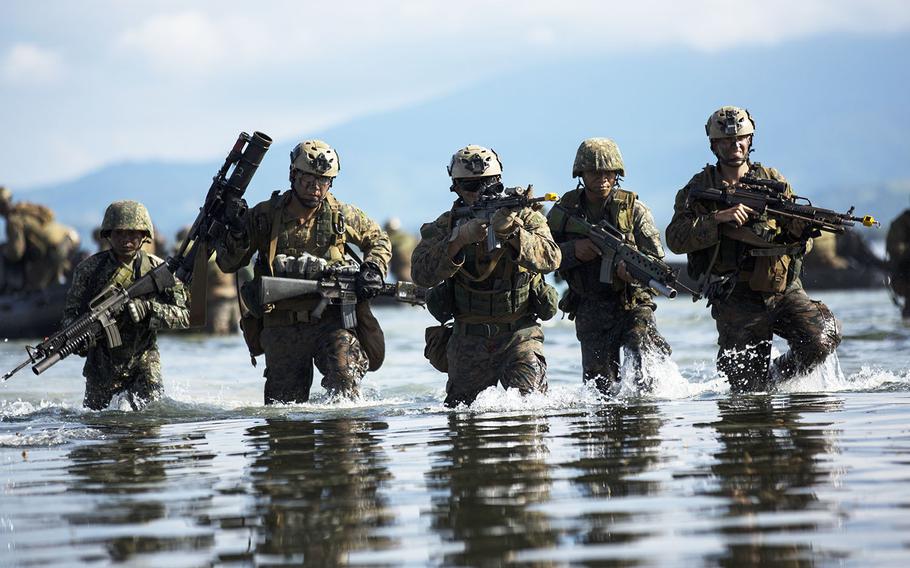
Philippine and U.S. Marines attack toward the beach during a simulated amphibious raid for Amphibious Landing Exercise (PHIBLEX) 15 in Palawan, Philippines, October 2, 2014. (Matthew Casbarro/U.S. Marines)
U.S. plans to rotate troops to five bases in the Philippines are just the beginning of an increased American presence in the country as part of an effort to protect wider interests in the region, Defense Secretary Ash Carter said Wednesday.
The Philippines bases that will host U.S. rotational forces — Antonio Bautista Air Base, Fort Magsaysay, Lumbia Air Base, Basa Air Base and Mactan-Benito Ebuen Air Base — were announced earlier this year after a Philippines court approved the Enhanced Defense Cooperation Agreement the two sides had signed in 2014.
But Carter, who spoke to reporters aboard a U.S. aircraft before arriving in Manila for three days of meetings, said he expects the number of bases to be used by U.S. troops to increase. He did not provide an exact number.
“That’s the beginning,” he said. “The agreement provides for more sites in the future — so there [will] be more but these are just the five initial sites.”
The five bases will allow for a “rotational presence for U.S. forces to operate with and out of the Philippines in support of … friends and allies in the region in defense, not only of our own interests but in our wider interests,” he said.
Antonio Bautista Air Base is located on Palawan Island. The location is about 100 miles away from the Spratly Islands, where China has reclaimed more than 2,000 acres of sea bottom in the South China Sea.
The U.S. and neighboring countries say China’s actions are provoking tensions in the region.
China has used its perceived rights over the territory in recent years to attempt to order U.S. military vessels and aircraft to change course; however, the U.S. considers the water and airspace to be part of the global commons under existing international law. The U.S. has twice conducted freedom-of-navigation sails within the 12-mile waters off the coasts of two of the man-made islands to show its disagreement with China’s claims.
China maintains an ambiguous claim to about 90 percent of the South China Sea. Those claims are disputed to some extent by Vietnam, Malaysia, Taiwan, Brunei, Indonesia, and the Philippines.
“The significance of … Palawan is its significance to the defense of the Philippines,” Carter said.
The Philippines, a former U.S. colony, is one of America’s oldest allies in Asia, and servicemembers from the two countries fought side-by-side against the Japanese in some of the bloodiest battles of the Pacific Theater in World War II.
In a wave of nationalism, the Philippines ejected the U.S. military from its extensive air and naval facilities in the country in 1991. But the threat of Islamist extremism in the south and Philippine concern over China’s claims in the South China Sea have led to a warming of military-to-military relations.
Last week, he announced that the U.S. was also providing the Philippines about $40 million this year to upgrade its secure communications networks to enable the country to more quickly communicate with U.S. Pacific Command in case of a natural disaster or security threat.
The funding will “help them do their part of our joint activities in the area of maritime security,” Carter said, “and the broader interests everybody here has in freedom of navigation.”
During his three-day stop, Carter is scheduled to attend the closing ceremonies of Balikatan, a massive U.S.-Philippines bilateral exercise. The exercise began last week and involves about 5,000 U.S. servicemembers and 3,500 members of the Philippines armed forces, said Pentagon spokesman Capt. Jeff Davis.
Twitter:@TaraCopp